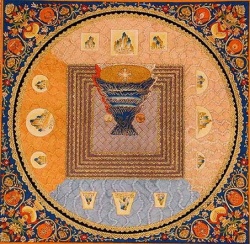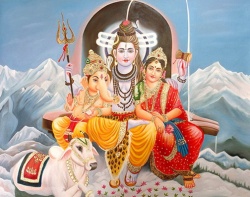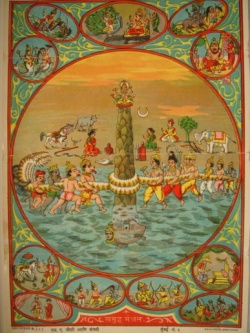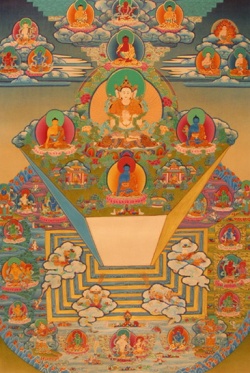Buddhist cosmic conundrum
Is the world or self eternal or not or both? Whether the world is finite or infinite or both or even not that? Whether even after attaining Nirvana does one exist or not or only dwell in deathlessness? These are few questions which haunts a common man since the olden days while addressing to the cosmic speculation within the framework of Buddhist philosophy.
Renowned scholar Dr.W. Randolph, who in his recent research Buddhist Cosmology writes that ‘The Buddha refused to answer these questions because they were vain and had no significance for salvation. All of the proposed alternatives are rejected by tradition as false or heretical. The scholastic difficulties inherent in apparent corollaries of these positions shed additional light on the implications of these cosmological questions.’
However, denying the importance of these cosmic speculations could "not prevent his followers from accepting the general cosmological beliefs of their time, modified by conclusions drawn from his specific moral and religions teachings" says Encylopeadia Britanica It further states that the cosmic phenomenon of creation, destruction and recreations are inevitable process ! Nothing is of permenant nature or transidental within the scope of the concept called "realm of desire", wherein gods, human being and other creatures are nothing but embodiment of impermanence.
One cosmic speculation states that the world system has four stages of becoming--the first layer is the heaven wherein six-tiers are there. Those are occupied by gods who are also impermenant but has longer duration of life. Then come the four-tired dvipa(Islands) around Mount Meru wherein the top is occupied by gods. Then there are Jambudvipa where in human beings and other creatures share that space. Below this dvipa there are terrible hells or a place for evildoers to suffer punishments.
With these speculations the concept of Heaven, Earth and Hell is promulgated which are inter-wovened with conditions of rebirth and by karma(action) one courses through the positions and layers to finally attain Nirvana or Moksha. Encyclopeadia Britanica sums up by saying ‘Depending upon their actions men are reborn in any of these five conditions: as gods, men, animals, tormented spirits,or in the hells. Later a sixth condition, that of Titans, was added. These five or six states represents the ever revolving wheel of life. When the world system comes to an end, the combined potency of previous actions(karman) restarts the whole process, just as present individual actions (which become Karmen in the future) result in a continuous life series (Sanatana) of apparently personal existences. Thus, for practical purposes, the process of existence appears as infinite, and only the practice of Buddhist teaching can bring it to an absolute end,which is the deathless state of enlightenment’.
The karma (actions of life) remains the basic essence of Buddhist cosmic speculations, however the Karmic manifestation is yet to be fathomed by us. In the Mahayanic practice we get some indication of cosmic Buddha based on his karma philosophy. Dr. Nalinaksha Dutt wrote in his article "Emergence of Mahayanic Buddhism" in Cultural Heritage of India that "The higher Mahayanic practices commence after {chapter} adhiprajna-vihara, i.e. in the seventh bhumi{textual layers} of the Dasabumika-Sutra,Henceforward the bodhisattva continues the practice of the four brahma-viharas,viz. maitri (friendliness), Karma (compassion), mudita (joy at other’s success) and upeksa (equaninity) tries to realize the substance lessness (Nairatmyas, Nissattva) and non-duality (advaya) of all objective existence which appear to him as echo or mirage, and strives to visual the cosmic body of the Buddha. He follows the ways of the world, but remains dissociated from them. He now goes beyond the sravaka and pratyeka-buddha stages."
Now again we come back to the question of Buddhist Cosmic conundrum after learning about cosmic Buddha within the definition of Karma. Academically speaking most scholars restrict their quest to the idea of single world and much of the treatise are written on this concept. However, Dr.W. Randolph Kloetzli has done some pioneering research and for the first opened up the four-tier cosmic symbolism. Those are Single World System, Cosmology of thousands; Cosmology of innumerables and the cosmologies of the pure land sects.
Dr. Kloetzli says that the single world system or ‘the cakravala is represented as a disk ringed with a series of seven circular golden mountain ranges. These mountain ranges are arranged concentrically with Mt. Meru at the centre and the Cakravala wall of iron at the perimeter.Proceeding outward from the centre, the mountains are known as Meru, Yugandhara, Isadhara, Khadisika,Sundarasana,Avakarana Vinataka, Nimindhara and cakravala...Mt.Meru has a height of 80,000 yojans and each of the mountain ranges is onehalf the height of the preceeding range. All of the mountains except the cakravala rings are excrescences of the golden earth. The cakravala ring is made of iron. The waters of the various seas(sita)fill the regions between the mountain ranges.The mountain penetrate these waters...processed of the following eight qualities; cold, clear swiftly, flowing,pleasant to the taste, fresh, inoffensive in smell, offensive to the neither throat nor the stomach.’
Furthermore, documents indicate that Mahasamudra flows about the seventh mountain ranges around dvipa as well. Coming to the celestial world of Mt. Meru it is said that there leaves two group of Gods i.e. Caturmaharajakayika and Trayastrimsa. However, there were foul classes of Caturmaharajakayika gods who live in parisanda or terraces of Mt. Meru.The Traystrimsa or celestial arena is ruled by Indra or Sakra who leave atop Mt. Meru.
The fourth heaven is of the Kamadeva.
These are some glimpses of cakkravala and cakravala cosmology referred by Dr.Koletzli. However, Dr. L.A. Waddell had sketched Lamist view of cakravala which is bit different and been dominating idea in the last century in amongst the lamas of Tibet.
Dr. Waddell wrote "Each Universe...rests upon a wrap and woof of ‘blue air’ or wind, liked crossed thunderbolts (Vajra)hard and imperishable as diamongs (vajra),upon which is set ‘the body of the waters’ upon which is a foundation of gold, on which is set the earth, from the axis of which towers up the great Olympus---Mt.Meru (Su-meru Tib. Rab) 84,000 miles high surmounted by the heaven and overlalying the hills.
In the ocean around this central mountain, the axis of Universe are set...four great continental world with their satellite, all with bases of solid gold in the form of a tortoise....And the continents are separated from Mt. Meru by seven concentric ring of golden mountains...The yoke alternating with seven oceans of fragnang, milk, curds, butter, blood or sugar juice, poison or wine, fresh water and salt water ....the whole system is girdled externally by a double iron wall(cakravala)312 and half miles high and 3,602,625 miles in circumference....This will shut out the light of the sun
and moon, whose orbit is the summit of the inmost ring of mountains, along with the sun composed of ‘glazed fore’ enshrined in a crystal palace, is driven in a chariot with ten (seven) horses; and the moon of ‘glazed water’ in a silver shrice drawn by seven horses, and between these two hand the jewelled umbrella of royalty and the banner of victory, as shown in the figure. And inhabitting the air, on a level with these, are the eight angelic or fairly mothers".
Thus we see even within the single concept cosmic variations and changes in the interpretative value are noticed though all the Buddhist idea still revolve around the cosmic Mountain Meru.
The "Cosmology of thousands" is another important aspect of Buddhist cosmological speculation. Dr. Kloetzli informed that there are thousands of worlds within the definition of Brahmaloka ‘the realm of the dhyana heavens’. The Buddhist textual tradition Majjhimankya gives us a striking example of these various worlds. He says ‘These we find a distinction between a shassobrahma governing a sahassi lokadhatu and equivalent realms governed by a dvishasso-brahma a trisahasso-brahma, a catusshasso-brahma,pancassohasso-brahma and stasahasso-brahma gods which rule over 1000 upto (1000) worlds’.
Moreover, we find the buddhaksetra is embodiment of sixty one triple chiliocosms.A further expression we find in La Valle Poussin’s translation of ancient text Avatamsakasutra which goes:
- ‘On whirlwinds rests the Fragrant ocean, which carries an infinite number of world-germs (lokabija); from it there issue lotuses infinite in number--very far removed, indeed, rom each other.From each of these lotuses is born a universe (great chilicosm) above which (separated bly whirlwinds) there are three, then five and so on upto the twentieth tiers, where there are 39 great chilicosms.... The Sahalokadhatu form part of the thirteenth stage, and constitutes the ‘field of the Buddha Vairocana, and.... on the same level at the same stage, in the extreme west, is blessed universe of the Buddha Amitabha, the Sukhavati, where a kalpa of our universe is equal to a day and a night’.
Further the Anguttara-nikaya explained that there are 1,000,000,000 Universes smaller and bigger thus giving birth to the concept of innumerable Universe. In the Pali texts of Buddhaghasa’s Atthasalini which says four things are infinite namely Space, The number of Universe, number of living beings and Wisdom of Buddha.
Thus the indication of infinite cosmology is found which denotes that manifestation of Buddha in 10 regional directions (dasadis) which are East(Purva); North-East (Uttarapurva); South East (Purvadakshina); West (Pasclhima); South West (Dakshinapaschima); North West (Paschimottara); South (Dakshina) North (Uttara).Then there are Urdvam (Zenith) and Adahah (Nadir).
In these ten directions the eternal light of Cosmic Buddha spreads all around Buddhakshetra the land of celestial Buddha within the concept of time and space. In Buddhist philosophy the soul is replaced with these eternal lights which are no mere cosmic jyoti but are embodiment of knowledge. To attain these knowledge one has to course through karma then the nirvana dawns upon which is the state of deathlessness or Moksha. One wonders, why Gautama Buddha only talked about Nirvana(emancipation and salvation) and not the cosmic world and avoided discussions on the speculative cosmic theories. Perhaps, Gautama realised that it was useless to discuss the Cosmology at the academic level rather one should get engaged to attain nirvana which is the state of realization and becoming and there one needs no cosmic theory to discuss because he merges into adibuddha the transidental one. Does all these indicate that the whole Buddhist cosmic theory is hidden in Nirvana which is a state of experiencing the eternal truth without any doubt or dilemma!
Dr Gautam Chatterjee



